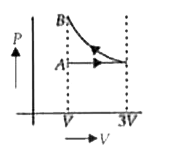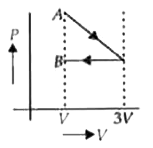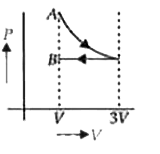A gas at initial temperature T undergoes sudden expansion from volume V to 2V. Then -
The process is adiabatic
The process is isothermal
The work done in this process is nRT Ine (2) where n is the number of moles of the gas
The entropy in the process does not change
The correct Answer is:A
For a sudden expansion Δθ=0 so the process is adiabatic.
Topper's Solved these Questions
- THERMODYNAMICSBOOK - ERRORLESSCHAPTER - THERMODYNAMICSEXERCISE - NCERT BASED QUESTIONS (ISOBARIC AND ISOCHORIC PROCESS)
10 Videos
- THERMODYNAMICSBOOK - ERRORLESSCHAPTER - THERMODYNAMICSEXERCISE - NCERT BASED QUESTIONS (HEAT ENGINE, REFRIGERATOR AND SECOND LAW OF THERMODYNAMICS)
35 Videos
- THERMODYNAMICSBOOK - ERRORLESSCHAPTER - THERMODYNAMICSEXERCISE - NCERT BASED QUESTIONS (ISOTHERMAL PROCESS)
16 Videos
- SURFACE TENSIONBOOK - ERRORLESSCHAPTER - SURFACE TENSIONEXERCISE - ASSERTION & REASON
11 Videos
- THERMOMETRY, THERMAL EXPANSION AND CALORIMETRYBOOK - ERRORLESSCHAPTER - THERMOMETRY, THERMAL EXPANSION AND CALORIMETRYEXERCISE - ASSERTION & REASON
10 Videos
Similar Questions
During an experiment an ideal gas is found to obey an additional law V2P = constant. The gas is initially at temperature T and volume V. When it expands to a volume 2V, the temperature becomes :
View SolutionDuring an experiment, an ideal gas is found to obey an additional law VP2=constant, The gas is initially at a temprature T, and volume V. When it expands to a volume 2V, the temperature becomes…….
View Solution
Knowledge Check
During experiment an ideal gas is found to obey an additional law VP2=constant. The gas is initially at temperature T and volume V, when it expands to volume 2V, the resulting temperature is
AT2B2TC√2TDT√2An ideal gas is found to obey and additional law VP2 = constant. The gas is initially at temperature T and volume V . When it expands to a volume 2 V , the temperature becomes
A√2TB2TC2√2TD4TOne mole of an ideal gas goes from an initial state A to final state B via two processes : It first undergoes isothermal expansion from volume V to 3V then its volume is reduced from 3V to V at constant pressure. The correct P-V diagram representing the two processes is
A B
B C
C D
D
One mole of an ideal gas goes from an initial state A to final state B via two processs : It first undergoes isothermal expansion from volume V to 3V and then its volume is reduced from 3V to V at constant pressure. The correct P−V diagram representing the two process in (figure)
View SolutionOne mole of an ideal gas goes from an initial state A to final state B via two processs : It first undergoes isothermal expansion from volume V to 3V and then its volume is reduced from 3V to V at constant pressure. The correct P−V diagram representing the two process in (figure)
View SolutionDuring an experiment, an ideal gas is found to obey a condition Vp2= constant. The gas is initially at a temperature (T), pressure (p) and volume (V). The gas expands to volume (4V).
View SolutionAn ideal gas is found to obey an additional laq P2V= constant. The gas is initially at temperature volume V. When it expands to a volume 2V, the temperature becomes-
View SolutionTwo samples A and B of a gas are initially at the same temperature and pressure are compressed from volume V1 to V/2 (A isothermally and B adiabatically). The final pressure is
View Solution
